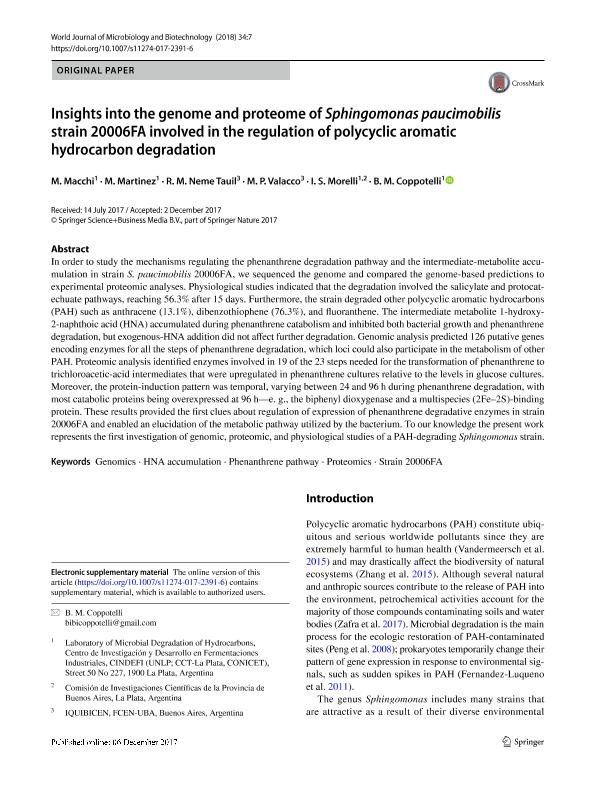Mostrar el registro sencillo del ítem
dc.contributor.author
Macchi, Marianela

dc.contributor.author
Martínez, M.
dc.contributor.author
Neme Tauil, Ricardo Martin

dc.contributor.author
Valacco, Maria Pia

dc.contributor.author
Morelli, Irma Susana

dc.contributor.author
Coppotelli, Bibiana Marina

dc.date.available
2018-11-26T15:51:54Z
dc.date.issued
2018-01
dc.identifier.citation
Macchi, Marianela; Martínez, M.; Neme Tauil, Ricardo Martin; Valacco, Maria Pia; Morelli, Irma Susana; et al.; Insights into the genome and proteome of Sphingomonas paucimobilis strain 20006FA involved in the regulation of polycyclic aromatic hydrocarbon degradation; Springer; World Journal of Microbiology; 34; 1; 1-2018; 1-14
dc.identifier.issn
0959-3993
dc.identifier.uri
http://hdl.handle.net/11336/65151
dc.description.abstract
In order to study the mechanisms regulating the phenanthrene degradation pathway and the intermediate-metabolite accumulation in strain S. paucimobilis 20006FA, we sequenced the genome and compared the genome-based predictions to experimental proteomic analyses. Physiological studies indicated that the degradation involved the salicylate and protocatechuate pathways, reaching 56.3% after 15 days. Furthermore, the strain degraded other polycyclic aromatic hydrocarbons (PAH) such as anthracene (13.1%), dibenzothiophene (76.3%), and fluoranthene. The intermediate metabolite 1-hydroxy-2-naphthoic acid (HNA) accumulated during phenanthrene catabolism and inhibited both bacterial growth and phenanthrene degradation, but exogenous-HNA addition did not affect further degradation. Genomic analysis predicted 126 putative genes encoding enzymes for all the steps of phenanthrene degradation, which loci could also participate in the metabolism of other PAH. Proteomic analysis identified enzymes involved in 19 of the 23 steps needed for the transformation of phenanthrene to trichloroacetic-acid intermediates that were upregulated in phenanthrene cultures relative to the levels in glucose cultures. Moreover, the protein-induction pattern was temporal, varying between 24 and 96 h during phenanthrene degradation, with most catabolic proteins being overexpressed at 96 h—e. g., the biphenyl dioxygenase and a multispecies (2Fe–2S)-binding protein. These results provided the first clues about regulation of expression of phenanthrene degradative enzymes in strain 20006FA and enabled an elucidation of the metabolic pathway utilized by the bacterium. To our knowledge the present work represents the first investigation of genomic, proteomic, and physiological studies of a PAH-degrading Sphingomonas strain.
dc.format
application/pdf
dc.language.iso
eng
dc.publisher
Springer

dc.rights
info:eu-repo/semantics/openAccess
dc.rights.uri
https://creativecommons.org/licenses/by-nc-sa/2.5/ar/
dc.subject
GENOMICS
dc.subject
HNA ACCUMULATION
dc.subject
PHENANTHRENE PATHWAY
dc.subject
PROTEOMICS
dc.subject
STRAIN 20006FA
dc.subject.classification
Otras Ciencias Biológicas

dc.subject.classification
Ciencias Biológicas

dc.subject.classification
CIENCIAS NATURALES Y EXACTAS

dc.title
Insights into the genome and proteome of Sphingomonas paucimobilis strain 20006FA involved in the regulation of polycyclic aromatic hydrocarbon degradation
dc.type
info:eu-repo/semantics/article
dc.type
info:ar-repo/semantics/artículo
dc.type
info:eu-repo/semantics/publishedVersion
dc.date.updated
2018-10-22T20:19:50Z
dc.journal.volume
34
dc.journal.number
1
dc.journal.pagination
1-14
dc.journal.pais
Alemania

dc.journal.ciudad
Berlin
dc.description.fil
Fil: Macchi, Marianela. Consejo Nacional de Investigaciones Científicas y Técnicas. Centro Científico Tecnológico Conicet - La Plata. Centro de Investigación y Desarrollo en Fermentaciones Industriales. Universidad Nacional de La Plata. Facultad de Ciencias Exactas. Centro de Investigación y Desarrollo en Fermentaciones Industriales; Argentina
dc.description.fil
Fil: Martínez, M.. Consejo Nacional de Investigaciones Científicas y Técnicas. Centro Científico Tecnológico Conicet - La Plata. Centro de Investigación y Desarrollo en Fermentaciones Industriales. Universidad Nacional de La Plata. Facultad de Ciencias Exactas. Centro de Investigación y Desarrollo en Fermentaciones Industriales; Argentina
dc.description.fil
Fil: Neme Tauil, Ricardo Martin. Consejo Nacional de Investigaciones Científicas y Técnicas. Oficina de Coordinación Administrativa Ciudad Universitaria. Instituto de Química Biológica de la Facultad de Ciencias Exactas y Naturales. Universidad de Buenos Aires. Facultad de Ciencias Exactas y Naturales. Instituto de Química Biológica de la Facultad de Ciencias Exactas y Naturales; Argentina
dc.description.fil
Fil: Valacco, Maria Pia. Consejo Nacional de Investigaciones Científicas y Técnicas. Oficina de Coordinación Administrativa Ciudad Universitaria. Instituto de Química Biológica de la Facultad de Ciencias Exactas y Naturales. Universidad de Buenos Aires. Facultad de Ciencias Exactas y Naturales. Instituto de Química Biológica de la Facultad de Ciencias Exactas y Naturales; Argentina
dc.description.fil
Fil: Morelli, Irma Susana. Consejo Nacional de Investigaciones Científicas y Técnicas. Centro Científico Tecnológico Conicet - La Plata. Centro de Investigación y Desarrollo en Fermentaciones Industriales. Universidad Nacional de La Plata. Facultad de Ciencias Exactas. Centro de Investigación y Desarrollo en Fermentaciones Industriales; Argentina. Provincia de Buenos Aires. Gobernación. Comisión de Investigaciones Científicas; Argentina
dc.description.fil
Fil: Coppotelli, Bibiana Marina. Consejo Nacional de Investigaciones Científicas y Técnicas. Centro Científico Tecnológico Conicet - La Plata. Centro de Investigación y Desarrollo en Fermentaciones Industriales. Universidad Nacional de La Plata. Facultad de Ciencias Exactas. Centro de Investigación y Desarrollo en Fermentaciones Industriales; Argentina
dc.journal.title
World Journal of Microbiology

dc.relation.alternativeid
info:eu-repo/semantics/altIdentifier/doi/https://doi.org/10.1007/s11274-017-2391-6
dc.relation.alternativeid
info:eu-repo/semantics/altIdentifier/url/https://link.springer.com/article/10.1007/s11274-017-2391-6
Archivos asociados
